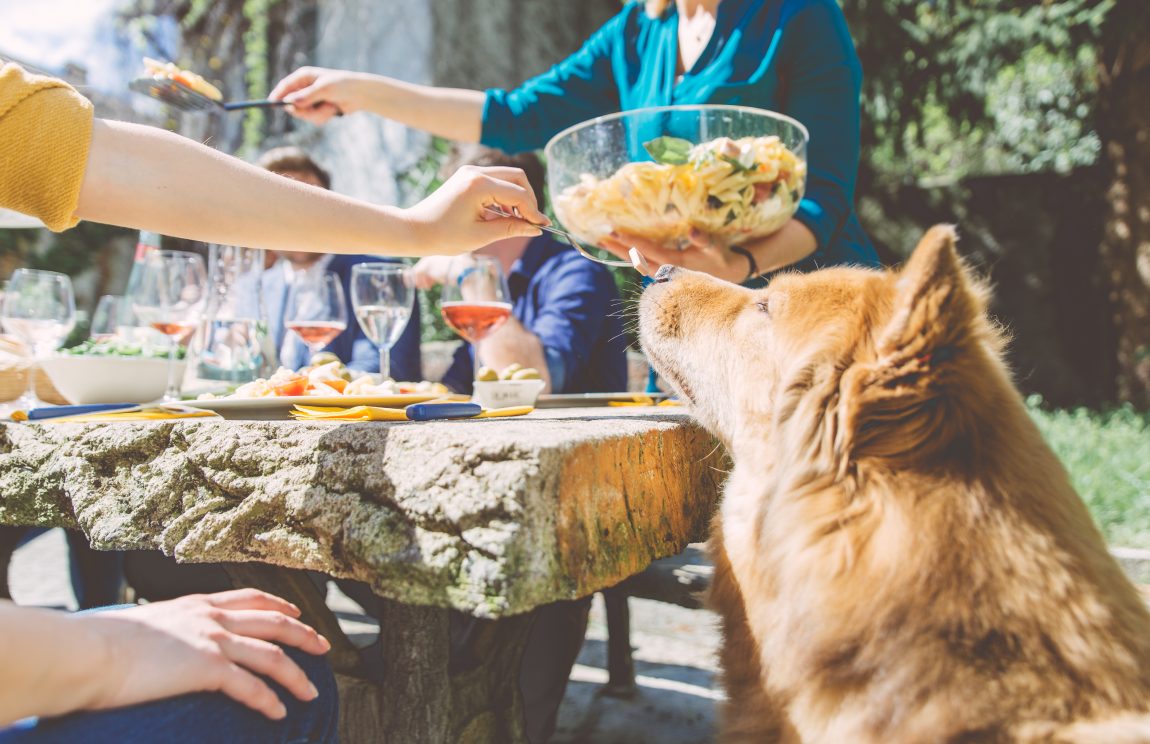
Always Listen To Your Veterinarian…..Why Should You Not Feed Your Dog From The Table?
We all love the delicious tastes and experiences of food! Mealtime is a great time to catch up with family, celebrate big moments, and make great memories. Food is a great way to spoil family and friends and plays a great role in bringing everyone together to share their love and support. Well, the same goes for our pets! Pet parents love to spoil their pets with “human” food to express their love. I cannot count the number of times I hear my pet parents proudly telling me that “last night Fluffy ate pan seared filet mignon with garlic and herbed butter. I secretly think to myself that Fluffy is one lucky pet, but while it very common to feed dogs from the table and give them all the delectable amazing foods that we eat, there are some health issues that can result from feeding your pet from the table. So, what are the problems that I see as a veterinarian with feeding your dog “human foods,” and what can we do to alleviate these problems?
Begging at the Table. This is a very common behavioral response I see when my pet patients are offered “human food” from the table. The moment dishes come out, the pets are at the table begging. Some “food beggars” are polite and keep their distance while their parents eat, however some cannot resist the temptation and keep reaching for the food on the table or putting their nose on your lap. While some of my pet parents do not mind this behavior, others have a very difficult time with it. Try to remember, dogs adapt behaviors to what their parents have taught them is acceptable. If you offer your pet table scraps, even at the end of your meal, your pet will learn that this is acceptable behavior and will act accordingly.
Picky Eaters. This is a very common behavioral response when patients normally eat from the table. Dogs are not dummies! They are going to choose a filet mignon over kibble every day of the week. Once your pets get a taste of “human” food, they are going to prefer the “human food” more than their dog food. I commonly receive complaints from clients that their pets will not eat their dog food. The first thing I ask is, “are you giving your pet people food?” Almost 100 percent of the time the response is “yes.” If your pet is refusing his or her food, the first step to getting them to eat more pet food is to stop giving them food from your table.
Obesity. Obesity in pets is a growing concern. I am seeing more and more overweight pets. Just like us, obesity can lead to other diseases such as heart disease, diabetes, joint problems, and more. When we feed our pets human food, it is hard to calculate how many additional calories are being added to their diets. Too often I hear from my clients that they are feeding their dogs the exact recommendations on the chart for their dog’s weight; however, they are not taking into account the extra calories their pet is getting from all the yummy treats. Be careful when feeding your pet table food. Without even realizing you could be giving them a whole extra meal each day, which can easily lead to obesity.
Unbalanced Diets. Many of my clients prefer to home cook their meals for their fur babies. I think this is great and I always encourage homemade meals for pets. One of the biggest concerns with home cooked diets is whether the diet is balanced. If you are cooking for your pet, it is so important to make sure your fur baby is getting the proper minerals, vitamins, nutrients, and proportions of food. I always recommend my clients refer to the website www.balanceit.com. This website is developed by a veterinarian nutritionist and provides exact measurements and sample diets that are easy to follow.
Gastrointestinal Upset. Unlike dogs, humans eat different foods daily and our gastrointestinal tracts develop and adjust according to what we eat. Pets on the other hand are used to eating the same food every day. The flora (or natural bacteria) that reside in the gastrointestinal tract to help digest and breakdown foods, develop and grow according to a pet’s consistent daily diet. When your pet eats something that they are not used to, like a steak or piece of cheese, their GI tracts go into “shock” trying to digest the new food. This can result in vomiting and diarrhea, and in more severe cases, pancreatitis. Always be careful when giving your pets table scraps.
Toxicity. There are so many “human foods” that are toxic to pets. For instance, did you know that you should never feed your dog grapes, as they can cause kidney disease in pets? The following is a list of foods that are toxic for our pets:
- Alcohol
- Onions, Garlic, Chives
- Citrus
- Grapes, Raisins, and Macadamia Nuts
- Milk and Dairy
- Coconut and Coconut Oil
- Salt and Salty Snack Foods
- Xylitol (a sugar alcohol used typically in sweeteners)
- Chocolate, Coffee and Caffeine
- Raw/Undercooked Meat, Eggs and Bones
- Yeast Dough
So, feel free to spoil your fur babies and give them all the love and affection that they deserve. Dogs are the best! They give back to us unfaltering love and dedication and rely on us to make all the best decisions for them, including what they eat. Make sure to avoid giving too much food from table. Although food can sometimes be a symbol for love and affection, in some cases it can cause harm and illness. As always, your pet’s health and wellbeing is always my top priority!




Not feeding our dogs from the table is a real struggle sometimes.
Thank you so much for following us;) Yes I understand the struggle and you are not alone. Try and tell yourself that in the long run you are helping them!! Hope this helps:)
I didn’t know about many of these being harmful!